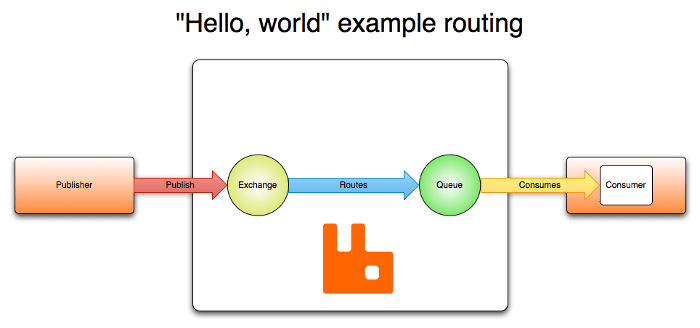Explore our expert-made templates & start with the right one for you.
Kafka vs. RabbitMQ: Architecture, Performance & Use Cases
This article is partially taken from our extensive 40-page eBook, “The Architect’s Guide to Streaming Data and Data Lakes.” Keep reading to learn about the key differentiator between Kafka and RabbitMQ. For a more comprehensive understanding, including in-depth comparisons of tools, detailed case studies, and a wealth of additional content, download the full eBook for free.
If you’re planning to incorporate Kafka into your data engineering architecture, don’t miss our comprehensive technical review, specifically focusing on Kafka’s role in real-time data analytics environments.
Kafka and RabbitMQ are two popular message queue system used in stream processing systems. But how do they differ, where do they overlap, and when should you choose one over the other? Read on to learn:
- Is Kafka or RabbitMQ best for your use cases?
- The different architectures an approaches behind each tool
- How Kafka and RabbitMQ handle messaging
- Performance pros and cons
- When you should use an end-to-end stream processing solutions
Need to transform data in motion? Consider Upsolver, our all-SQL data pipeline platform that lets you write a query and get a pipeline from batch and streaming data – while automating orchestration, file system optimization and infrastructure management. You can execute sample pipeline templates, or start building your own, in Upsolver for free.
The Basics: What are Apache Kafka and RabbitMQ?
Apache Kafka and RabbitMQ are two open-source and commercially-supported pub/sub systems, readily adopted by enterprises. RabbitMQ is an older tool released in 2007 and was a primary component in messaging and SOA systems. Today it is also being used for streaming use cases. Kafka is a newer tool, released in 2011, which from the onset was built for streaming scenarios.
What is RabbitMQ? RabbitMQ is a general purpose message broker that supports protocols including MQTT, AMQP, and STOMP. It can deal with high-throughput use cases, such as online payment processing. It can handle background jobs or act as a message broker between microservices.
What is Apache Kafka? Kafka is a message bus developed for high-ingress data replay and streams. Kafka is a durable message broker that enables applications to process, persist, and re-process streamed data. Kafka has a straightforward routing approach that uses a routing key to send messages to a topic.
Kafka vs RabbitMQ – Differences in Architecture
RabbitMQ Components Architecture
The main components of RabbitMQ can be seen from the diagram below:

As with other message brokers, RabbitMQ receives messages from applications that publish them – known as producers or publishers. Within the system, messages are received at an exchanges – a virtual ‘post-office’ of sorts, which routes messages onwards to storage buffers known as queues. Applications that read messages, known as consumers, can subscribe to these queues to pick up the latest data that arrives in the ‘mailboxes’.
The key features of RabbitMQ are:
- General purpose message broker—uses variations of request/reply, point to point, and pub-sub communication patterns.
- Smart broker / dumb consumer model—consistent delivery of messages to consumers, at around the same speed as the broker monitors the consumer state.
- Mature platform—well supported, available for Java, client libraries, .NET, Ruby, node.js. Offers dozens of plugins.
- Communication—can be synchronous or asynchronous.
- Deployment scenarios—provides distributed deployment scenarios.
- Multi-node cluster to cluster federation—does not rely on external services, however, specific cluster formation plugins can use DNS, APIs, Consul, etc.
Apache Kafka Architecture
You can see the main components of a Kafka cluster below:

Producers and consumers are the same here – applications that publish and read event messages, respectively. As we’ve covered when we discussed Kafka use cases, an event is a message with data describing the event, such as a new user signing up to a mobile application. Events are queued in Kafka topics, and multiple consumers can subscribe to the same topic. Topic are further divided into partitions, which split data across brokers to improve performance.
Important features of Kafka include:
- High volume publish-subscribe messages and streams platform—durable, fast, and scalable.
- Durable message store—Kafka behaves like a log, run in a server cluster, which keeps streams of records in topics (categories).
- Messages are made up of a value, a key, and a timestamp.
- Dumb broker / smart consumer model—does not try to track which messages are read by consumers and only keeps unread messages. Kafka keeps all messages for a set period of time.
- Managed by external services—in many cases this will be Apache Zookeeper.

Pull vs Push Approach – Kafka and RabbitMQ Compared
One important difference between Kafka and RabbitMQ is that the first is pull-based, while the other is push-based. In pull-based systems, the brokers waits for the consumer to ask for data (‘pull’); if a consumer is late, it can catch up later. With push-based systems, messages are immediately pushed to any subscribed consumer. This can cause these two tools to behave differently in some circumstances.
Apache Kafka: Pull-based approach
Kafka uses a pull model. Consumers request batches of messages from a specific offset. Kafka permits long-pooling, which prevents tight loops when there is no message past the offset, and aggressively batches messages to support this
A pull model is logical for Kafka because of partitioned data structure. Kafka provides message order in a partition with no contending consumers. This allows users to leverage the batching of messages for effective message delivery and higher throughput.
RabbitMQ: Push-based approach
RabbitMQ uses a push model and stops overwhelming consumers through a prefetch limit defined on the consumer. This can be used for low latency messaging..
The aim of the push model is to distribute messages individually and quickly, to ensure that work is parallelized evenly and that messages are processed approximately in the order in which they arrived in the queue. However, this can also cause issues in cases where one or more consumers have ‘died’ and are no longer receiving messages.
RabbitMQ vs Kafka – How Do They Handle Messaging?
| Tool | Apache Kafka | RabbitMQ |
| Message ordering | provides message ordering thanks to its partitioning. Messages are sent to topics by message key. | Not supported. |
| Message lifetime | Kafka is a log, which means that it retains messages by default. You can manage this by specifying a retention policy. | RabbitMQ is a queue, so messages are done away with once consumed, and acknowledgment is provided. |
| Delivery Guarantees | Retains order only inside a partition. In a partition, Kafka guarantees that the whole batch of messages either fails or passes. | Doesn’t guarantee atomicity, even in relation to transactions involving a single queue. |
| Message priorities | N/A | In RabbitMQ, you can specify message priorities and consume message with high priority first. |
Supported libraries and programming languages
According to the intro guide provided on the Apache Kafka website, Kafka provides clients for a variety of programming languages and libraries. It ships with some clients included, which are augmented by dozens of clients provided by the Kafka community. These clients are available for Java and Scala including the higher-level Kafka Streams library, for Go, Python, C/C++, and many other programming languages as well as REST APIs. In addition, Kafka Connect provides hundreds of ready-to-use connectors for external systems and applications.
According to the article Interoperability in RabbitMQ Streams and the list of supported protocols, RabbitMQ supports a wide range of libraries and programming languages, such as Java, Go, .NET, and many others; as well as the AMQP 0.9.1, AMQP 1.0, STOMP, and MQTT protocols. There are also a large number of client libraries available for different programming languages and environments,
Kafka vs RabbitMQ Performance
Apache Kafka:
Kafka offers much higher performance than message brokers like RabbitMQ. It uses sequential disk I/O to boost performance, making it a suitable option for implementing queues. It can achieve high throughput (millions of messages per second) with limited resources, a necessity for big data use cases.
RabbitMQ:
RabbitMQ can also process a million messages per second but requires more resources (around 30 nodes). You can use RabbitMQ for many of the same use cases as Kafka, but you’ll need to combine it with other tools like Apache Cassandra.
What are the Best Use Cases?
Apache Kafka Use Cases
Apache Kafka provides the broker itself and has been designed towards stream processing scenarios. Recently, it has added Kafka Streams, a client library for building applications and microservices. Apache Kafka supports use cases such as metrics, activity tracking, log aggregation, stream processing, commit logs, and event sourcing.
The following messaging scenarios are especially suited for Kafka:
- Streams with complex routing, throughput of 100K/sec events or more, with “at least once” partitioned ordering.
- Applications requiring a stream history, delivered in “at least once” partitioned ordering. Clients can see a “replay” of the event stream.
- Event sourcing, modeling changes to a system as a sequence of events.
- Stream processing data in multi-stage pipelines. The pipelines generate graphs of real-time data flows.
RabbitMQ Use Cases
RabbitMQ can be used when web servers need to quickly respond to requests. This eliminates the need to perform resource-intensive activities while the user waits for a result. RabbitMQ is also used to convey a message to various recipients for consumption or to share loads between workers under high load (20K+ messages/second).
Scenarios that RabbitMQ can be used for:
- Applications that need to support legacy protocols, such as STOMP, MQTT, AMQP, 0-9-1.
- Granular control over consistency/set of guarantees on a per-message basis
- Complex routing to consumers
- Applications that need a variety of publish/subscribe, point-to-point request/reply messaging capabilities.
Kafka and RabbitMQ: Summing Up
This guide has covered the major differences and similarities between Apache Kafka and RabbitMQ. Both can consume several million messages per second, though their architectures differ, and each performs better in certain environments. RabbitMQ controls its messages almost in-memory, using a big cluster (30+ nodes). Comparatively, Kafka leverages sequential disk I/O operations and thus demands less hardware.
To learn more about the differences between Kafka and other message brokers, check out our guide to Kafka vs Kinesis, our our glossary item defining Kinesis data streams.
You Have Streaming Data in Kafka. What’s Next?
Getting your data in Kafka is just the first step – to actually drive value from it, you need a way to easily store, manage and analyze your streams. To learn how that’s achieved, check out our popular post on Apache Kafka with or without a Data Lake.

